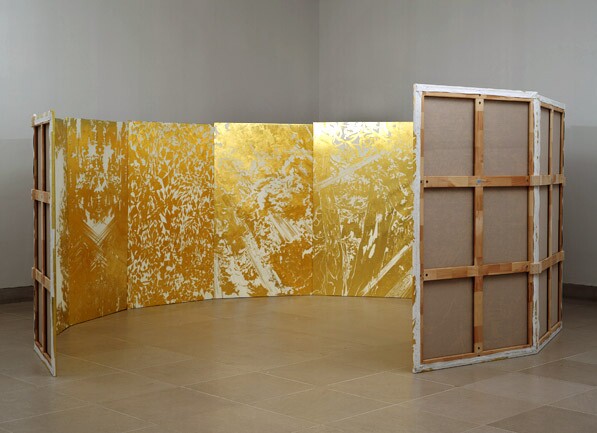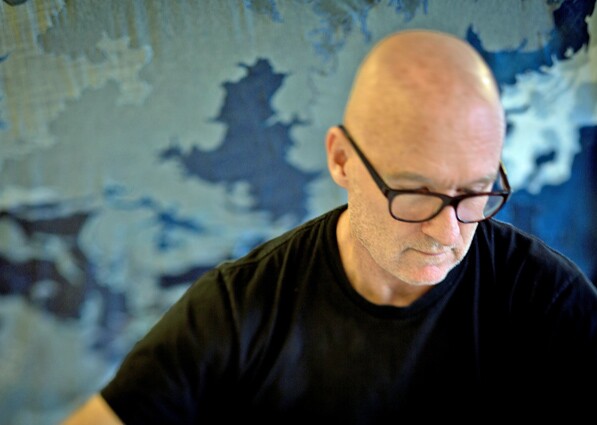Extraordinary Ordinary: Jim Hodges at the Hammer
Although they seem a considerable distance from each other, the assemblages of Jim Hodges at the Hammer Museum (until January 18) and the photographs of Larry Sultan at LACMA (until March 22) are kin in a way. Perhaps it's the common tenderness in the work of each of the artists. Perhaps it's the way each of them gathers up and repurposes the discarded stuff of everyday life.
Or perhaps it's "the hunger of memory" that consumed Sultan and tugs insistently at Hodges.
Both Hodges and Sultan (who died in 2009) are getting broadly retrospective exhibitions at a time when the ordinary is getting unironic again. I take this change to be a good thing (although L.A. Times art critic Christopher Knight is more skeptical about Hodges' uses of the everyday.)
Hodges is best known for his adaptation of discarded stuff: old denim sewn into a tapestry, thrift shop scarves as a wall hanging. Castoffs from the ordinary have been seen a lot in the art of the past hundred years (think of Braque and Picasso). Those disregarded bits have been made to serve as markers of class solidarity, of defections from the marketplace of art, of sentimentality masquerading as humility, and of elegiac longing almost too naked to witness.
It's the pathos of the everyday that marks Hodges' art, a stigma his critics will not accept. Under our regime of speed, we're told to lighten ourselves of the things that remember us, especially when these things are so much in need of our remembrance. The feelings left are outrage (in politics), snobbery (in cultural affairs), and numbness (in all our other affairs).

Or you could fall in love. As Walker Executive Director Olga Viso notes in her catalog essay, Eros is the figure behind the incised photographs, doodled paper napkins, fractured mirrors, light bulbs, silk flowers, metal work, and embroidery that populates Hodges' profusion.
I'm reminded of William James' comment about the "great blooming, buzzing confusion" of the sensory world and James' attempt to find a fit rhetoric for its perception. "Experience, from the very first," James wrote in "Principles of Psychology" (1890), "presents us with concretized objects, vaguely continuous with the rest of the world which envelops them in space and time, and potentially divisible into inward elements and parts. These objects we break asunder and reunite. We must treat them in both ways for our knowledge of them to grow; and it is hard to say, on the whole, which way preponderates."
If James is right, our commonplace selves are much like Jim Hodges. Perception under the influence of love is decomposition without malice (all those silk flowers Hodges dismembered and pinned up) and re-composition with a purpose (those silk flowers sewn into a network and cascading in the gallery's even light). From there, more making and breaking.
Hodges sees this process explicitly as biography. But when I walked though the Hammer's galleries with Chief Curator Connie Butler, I wasn't checking off his life events. My eye goes to the thing itself and to the thing's self-possession.
The best things in the Hodges retrospective have that élan though often camouflaged. (Somewhere in the root meeting of camouflage is a loss that has taken place out of sight or subterranean.) The veil, of course, is mortality.

Mortality shouldn't be misunderstood as transience, as so many of Hodges admirers and critics do. For all their lightness -- or the effect of light breaking through -- in works like "Untitled (one day it all comes true)" and "and still this," Hodges' assemblages seem to be working out the implications of a quote Hodges sent to an acquaintance from Jean Genet's novel "Miracle of the Rose":
Certain acts dazzle us and light up blurred surfaces if our eyes are keen enough to see them in a flash, for the beauty of a living thing can be grasped only fleetingly. To pursue it during its changes leads us inevitably to the moment when it ceases, for it cannot last a lifetime. And to analyze it, that is, to pursue it in time with the sight and imagination, is to view it in its decline ...
Much has been said about the narrative (or literary) qualities of Hodges' work, not always favorably. Narrative is supposed to be too accessible, even simple. Allegory and metaphor are to be used only in the service of polemic. Those are traps Hodges avoids.
The everyday is entire but not finished, and several of the works in the Hammer exhibition play on this observation. The cynic (or the stoic) might assert that life (or history) is just one damn thing after another to disparage Hodges' fragile accumulations of deli napkins with sketches of flowers, mirror fragments, more silk flowers, and bits of links in a chain.
Hodges reply is that the commonplace is the place where we necessarily find love and hope.



